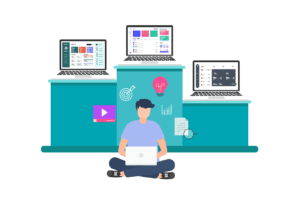With the ever-changing digital landscape, one thing’s for certain: e-learning is here to stay, and for good reason. The benefits of online courses and advantages of online learning for educators, employees, students, and learners are unparalleled in terms of retention and scalability.
Over the past few years, we’ve seen a boom in the development of learning management systems (LMS) to meet and keep up with the demand for online course delivery.
While these LMS plugins and platforms all provide varying suites of features, and some may be better suited for one industry in comparison to another, there are 6 advantages of e-learning that stand true for almost every business and education sector.
1: Reduced Time and Spending
One of the greatest benefits of delivering content through an e-learning platform is that is saves time and money for the course administrator. Elearning offers these highlights when compared to traditional options:
- Faster Learning – According to elearningindustry.com, students consume online lessons and material 25-60% faster than they would if the same content was delivered in a traditional learning environment.
- No Commute – The lack of physical travel is a double win, which saves time and money by eliminating the commute. Anyone with an internet connection can learn, making educational opportunities a global possibility.
- Physical Materials are Reduced or Eliminated – It’s cost-effective compared to the materials needed to deliver an in-person education. The reduction in printed materials is a savings for both the student and the educator.
These three areas reduce the cost of continued education for companies and organizations.
And what is also important to note is the intangible benefits. The move to e-learning technology frees up both the student and the educator mentally and financially. This allows them to reallocate resources to activities that promote a healthy work-life balance.
2: Flexible Learning Environment
Using an online learning platform makes it possible for you to create an environment that puts your students and employees front and center.
For example, an employee can look at the educational menu or search for the method that will help them improve their skills. This added option can improve workplace employee training, without putting a strain on instructor-based learning.
You’re able to deliver the same material through various mediums to accommodate each student’s learning style. This may even reduce learning time because e-learning makes it easier to access a lesson when you’re on the go.
For each lesson, you can provide a self-paced pre-recorded video lecture paired with slides of examples and notes.
E-Learning allows learners to consume the content via the medium that will benefit them the most. This puts more control in the students’ hands, which will amplify their learning experience.
3: Increased Retention
Having the ability to consume content through interactive tech solutions is a sure-fire way to increase retention of the material.
Recorded training materials allow a student to replay any of the content on an as-needed basis. This could provide an immediate replay of challenging material or it could serve as a refresher for older material.
These checkpoints of quizzes or homework help ensure the student is completing the material and retaining the information.


You can even set up your online courses to only allow a user to unlock or move on to the next lesson when they’ve completed the prior lesson.
This completion status may be driven by a passed quiz, a watched video, a completed homework assignment, or even a self-assessment. The key is you are allowing learners to progress in a self-paced method.
Once you have a solid foundation in place for delivering your courses, consider adding in LMS gamification to issue points and reward your employees or learners for their efforts.
4: Scalability
Hosting your training classes and lessons on the internet makes it possible for you to scale without increasing your costs.
As an educator, you’re able to reach more students than you could inside a traditional classroom. You can offer free or paid courses or even memberships. High education institutions have already discovered the importance of scalability and there are over offered online by Ivy League universities.
Modern organizations, entrepreneurs, and corporations are taking their training classes and seminars online to reach even more people. Geography is no longer a constraint to finding students who will benefit from what they have to offer.
You can use an online course platform to train and onboard new team members, train athletes, provide group coaching or strategy sessions, and business training to the masses.
Here at AccessAlly, our users have tripled the number of members enrolling in their learning programs and increased their revenue.
5: Personalization
With the advancements in learning management systems, you can create a truly personalized experience for each learner, especially with the integration of hybrid work software if they are working in a hybrid environment or remotely..
Not every student learns at the same speed, or in the same way. Online courses allow each student to work through the material at a pace ideal for them.
While including deadlines is a great way to motivate students to work towards completion, you’re still able to provide each student with the opportunity to work through the material at a rate that’s supportive of their learning style.
Most online learning platforms make it possible to trigger notifications for each employee or student based on their progress to keep them engaged with the material. So they can improve their skills or better their life.
6: Reduced Carbon Footprint
A reduced carbon footprint is another intangible advantage, but it is a critical one for many organizations.
At AccessAlly we’re committed to doing as much as we can to reduce our carbon footprint, which is why we’re firm believers in the power of e-learning. Our premium membership management and LMS plugin make it possible for leaders around the world to teach online.
E-learning helps to eliminate the need for printing workbooks and paper materials for students.
It reduces the need for travel to and from the classroom or office and it cuts back on the resources needed to maintain a physical location for classes and training. It creates a harmonious blend of eco-friendly, student-friendly education.
More Advantages & Benefits
Our list of six benefits are just a few of the advantages of e-learning, but so many more are present and why more modern educators and business owners are moving their courses online.
Almost any industry can benefit from the advantages of online learning. The challenge isn’t in finding the reason to adopt online learning, instead, it’s finding the right LMS software platform to create your ideal learning environment.


How to Choose Your Learning Management System
The LMS marketplace can be overwhelming, but here are 5 criteria to help you narrow down your search.
1. Choose a Flexible Tool
You want to choose an LMS plugin or platform that makes setup easy, but has the flexibility to grow with you. While you can hire a team of designers and developers, this should be a choice and not a requirement.
We recommend choosing a WordPress LMS plugin so you own your content, and aren’t at the mercy of a closed platform that makes it hard to take your content with you if they change their business model or pricing.
2. Choose a Robust Solution
When looking for an online learning package, you want to stay focused on a fully functional end-to-end solution that will play well with other software.
Reduce your tech stack and choose a training tool that includes all of the features you need, and doesn’t require you to duct tape products developed by different companies.
We love WordPress, but combining ten different plugins together to build up an LMS suite can take a log of time, energy, and money. It’s better to find something all-inclusive, so you can focus more on your content and students and less on the software.
A best-of-breed LMS solution will provide features and functionality that are tightly integrated. It will allow for third-party tools like CRM software to integrate as well.
3. Choose a Tool That Delivers Engagement
Your e-learning environment should include powerful gamification and e-learning features for:
- Tracking students’ progress through your lessons
- Offering quizzes to test retention and comprehension
- Generating PDF certificates of completion and rewards students
- Tracking your students’ video views, logins, and footprints across your site
- Receiving student homework and submitting private critiques and feedback
The more you engage your students, the more they will spend time learning. The more they learn, the more value your training becomes to them.
Don’t miss out on the benefits of gamification in learning by using an LMS that isn’t compatible. Gamification isn’t offered by every LMS package, so watch for this feature and select only those packages that offer the functionality needed to keep students engaged and on-task.
4. Choose a Well Coded Tool
You want to choose an e-learning platform that was created by a software development company that is in it for the long haul, that won’t lock you out of the code, and that is constantly co-creating new features with users.
When reviewing your LMS providers, look for the following eLearning company success indicators:
- Experience of the team
- Frequency of software updates
- Integration options to third-party software packages
- Availability of documentation
- Availability of support
Quality code and support aren’t the cheapest option available, but are well worth the money.
You’ll spend a lot of time developing your eLearning teaching. So you need to know a developer will be there to support you during setup, at launch, and as you grow.
5. Choose a Tool That Prioritizes the Learner Experience
Choose an e-learning solution that provides you with design freedom, is customizable, mobile responsive. And that will grow with you as you continue to fine-tune your digital-based learning journey.
A core part of successful e-learning is creating an exceptional user experience. This means the architecture, course flow, and design all need to support the teaching through technology.
Demo your LMS options, so you can get a good preview of setup options, student dashboards, and layout. The more you know before purchase, the better experience you’ll create for your future students or employees.
AccessAlly fits the bill for all five of these criteria, and then some.






